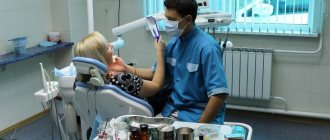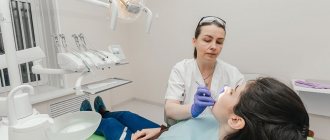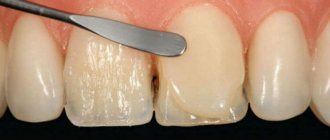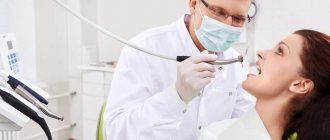You can often hear that dental treatment is carried out by a dentist, dentist or stomatologist, which is the same thing. In fact, these are different professions, and in order to know which specialist to contact if necessary, it is useful to know what the differences are in these specialties.
To obtain a diploma as a dentist (they are called dentists abroad), you need to graduate from a medical school or college with a specialty in Dentistry. A dentist is a specialist with higher education who has completed training at a medical university or institute.
A dentist does not immediately receive the right to practice independently. After graduating from the institute, he must undergo a two-year postgraduate internship - an internship, working under the supervision of an experienced colleague-manager.
Tasks of a dentist-therapist
The initial visit to a dental clinic begins with an appointment with a dentist-therapist. The main task of this doctor is to make the correct diagnosis. If job responsibilities allow, the doctor will begin treatment of the disease, or give a referral to a dentist of a different profile. In addition, his competence includes:
- carrying out preventive examinations;
- diagnosis of the primary disease;
- based on the conclusions of instrumental examination methods, establishing a final diagnosis;
- determination of patient management tactics;
- development of a survey program;
- provision of qualified medical services help in your specialty;
- identification of etiological causes of pathology;
- treatment of caries and its complications (pulpitis, periodontitis, granuloma);
- correction of traumatic damage to teeth (cracks, chips);
- elimination of defects of non-carious origin (fluorosis, dentinogenesis, others);
- treatment of diseases of the gums and mucous membranes of the oral cavity;
- providing advice to doctors of other specialties.
In the process of work, the dentist-therapist carries out manipulations: removes hard tissues destroyed by caries, depulps nerves, fills root canals, seals cavities with fillings, etc. To perform the assigned tasks, the doctor uses dental instruments, special equipment, medications, antiseptics, composite materials .
What does a dentist do?
A dentist is essentially a dental assistant. His responsibilities include conducting preventive examinations and physical procedures, treating simple dental diseases - caries, stomatitis, periodontitis.
A mid-level medical worker can provide first aid for acute inflammatory processes and knows the basic technique of tooth extraction. If necessary, he gives a referral to a more highly qualified specialist - a dentist.
Problems solved by a therapist in dentistry
The most common reason for visiting this dentist is toothache of varying intensity. In addition, the following symptoms become a reason to contact a dentist-therapist:
- Gums bleed when brushing teeth and chewing food;
- the enamel has changed color;
C - white, yellow, brown, black spots appeared on the enamel;
- a piece of the tooth crown broke off;
- cracks have formed on the surface of the segments;
- the filling fell out of the cavity;
- a painful reaction to cold (hot), sour (sweet) food appeared;
- bad breath;
- swollen gums;
- other oral problems.
You should visit your dentist twice a year for a preventive examination, even if you have no pathological symptoms. This will help to promptly identify the disease at the beginning of the process, which will simplify its treatment and increase the chance of successfully getting rid of the problem.
What is the difference between a dentist and a dentist: who is he and what does he do?
The word “dentist” is rarely used in our country; most often this is the name given to foreign specialists involved in the treatment of oral diseases. In the Russian-speaking environment, it is synonymous with the concept of “dentist”.
Orthopedic dentist - description of specialty
The name “orthopedic dentistry” was given to medical qualifications for the protection, restoration and prosthetics of the maxillofacial area. Sooner or later, every person needs to protect damaged tissue with a crown or prosthetics. The rating of dentists is opened by an orthopedist.
Situations in which the help of an orthopedist is needed:
- Tooth decay and loss. In this case, its function is restored by installing an artificial one.
- Protection from destruction. If only part of the bone tissue has been corroded, and the roots are intact and healthy, a crown is installed on such dental tissue, which stops further destructive process.
- The teeth are completely intact and healthy, but their appearance does not suit the owner. Installing ceramic plates will eliminate problems such as chips and scratches.
If the tooth tissue and root are healthy, then restoration is sufficient. Otherwise, prosthetics are performed. To determine what treatment plan is needed, the doctor conducts an examination, after which he makes a dental modeling in his laboratory. The orthopedist also deals with the correction of the appearance of the dental system, i.e. issues of aesthetic dentistry.
- Tooth decay and loss. In this case, its function is restored by installing an artificial one.
- Protection from destruction. If only part of the bone tissue has been corroded, and the roots are intact and healthy, a crown is installed on such dental tissue, which stops further destructive process.
- The teeth are completely intact and healthy, but their appearance does not suit the owner. Installing ceramic plates will eliminate problems such as chips and scratches.
What diseases does the dentist treat?
A general practitioner in dentistry treats the most common dental diseases:
- Caries. This is the process of destruction of hard tooth tissues under the influence of pathogenic bacterial flora present in the mouth. Characterized by demineralization and the formation of a carious cavity. The initial stages occur without pain. It is detected as a small dark spot on the enamel when examining the oral cavity. In the absence of timely dental treatment, pathology spreads to the dentin located under the enamel.
- Pulpitis. The disease consists of inflammation of the pulp, which is represented by connective tissue located under the dentin. The pulp includes vascular bundles and nerve endings that nourish and innervate the tooth. As a result of untreated caries, bacteria penetrate inside the tooth, causing inflammation of the pulp. The first sign of pulpitis is acute paroxysmal pain, intensifying at night, radiating to neighboring units, to the ear, and temple.
- Periodontitis is a complication of caries and pulpitis, in which the inflammatory process spreads to the periodontal tissue surrounding the tooth root. The main causes of periodontitis are: infection, trauma, potent drugs used in the treatment of pulpitis (formalin, arsenic). It can occur in acute and chronic forms, on which clinical symptoms depend.
- Periostitis (flux) is inflammation of the periosteum. Refers to a complication of dental diseases. Sometimes it develops as a result of a general inflammatory process in the body. Leading symptoms:
- toothache spreading to the area of the eye, ear, temple;
- swelling of the gums, spreading to the cheek and neck, causing facial asymmetry;
- hyperemia of the mucous membranes;
- pus on the gum near the sore tooth;
- soreness of nearby lymph nodes;
- hyperthermia;
- general weakness, others.
After the pus leaves the lesion, the symptoms weaken, but this does not mean that you can no longer seek help from a dentist, since the pathological process inside continues and can lead to undesirable consequences (phlegmon, osteomyelitis).
North-Eastern Dental Center No. 1 on Otradny provides a wide range of services in various areas of dentistry. Thanks to the high professionalism of our dental therapists, we treat teeth reliably, without pain, at reasonable prices. The clinic is equipped with advanced dental equipment and the best imported filling materials. You can make an appointment by calling 8 (499) 204 10 10, or leave a request on the website, we will call you back ourselves.
How to find a good pediatric dentist
Dental treatment should be done by professionals. To become a dentist you need to study at a medical school for five years. After this, you need to spend two years in residency. A future professional doctor must undergo an internship. Dentists are required to understand :
- dental system;
- physiology;
- human anatomy.
After graduating from university, they should choose a specialization. Doctors who treat children's teeth must not only understand dentistry, but also be able to find an approach to the child. Doctors have a responsibility to stay up to date with the latest techniques. They must use gentle methods of therapy. If you decide to find a good pediatric dentist
in
Moscow
, then you need to choose a trusted clinic and read reviews about the specialist’s work.
conclusions
There are a lot of specialists in dentistry, and the activities of each of them are different. It is important to remember that you can avoid serious oral health problems and trips to dental clinics if you follow the basic rules:
- brush your teeth twice a day;
- visit the dentist once a year, even if there is no reason for this;
- Do not delay your visit if your gums become sensitive or inflamed.
By following these conditions, you will protect yourself from problems in the future. Do not be afraid of doctors; many diseases begin completely asymptomatically, and only a specialist will be able to identify the threat in time.
What is the difference?
What is the difference between a dentist and a dentist?
Despite the fact that these two words are synonymous, there are still significant differences between these medical professions. Specialists who graduate from a secondary medical institution, having studied there for 3 years, receive the qualification “dentist” and have the right to treat teeth and the oral cavity for limited medical reasons. These are simple manifestations of caries, periodontal disease, and stomatitis. College graduates can provide care for patients with maxillofacial injuries and carry out simple physiotherapeutic procedures, diagnose the disease and, in cases where the situation is complex, refer them for treatment to a more qualified doctor. A dentist will take on any possible diseases of the mouth and teeth; he is entitled to this by graduating from a dental university, where he studied for 5 years, plus completing a two-year residency or a year of internship. Therefore, he has a higher qualification and level of training.
But the development of medical dental science and the demands of the time have shown that simply being a dentist is not enough, so narrow specializations of this area of medicine have appeared:
- dental surgeons;
- dental therapists;
- general dentists;
- orthodontists;
- pediatric dentists;
- orthopedic dentists.
These highly qualified professionals each specialize in their own field, which allows them to penetrate deeper into the intricacies of the field, get acquainted with new achievements of science, high technologies and implement them into practice.
Who is a dentist and what is the difference between him and a dentist?
A dentist is a specialist who has devoted his knowledge and accumulated experience to providing a variety of dental care to patients, but does not have a higher medical education and is limited in his activities to tasks related to the implementation of specific types of treatment. The secondary medical education he received gives him the opportunity to eliminate simple dental problems and become a sought-after universal specialist, especially in compact medical institutions or sparsely populated areas.
A dentist is a highly qualified specialist, the basis of which is a higher medical education obtained at a university, which allows him to treat the entire spectrum of diseases of both the maxillofacial system and the oral cavity. You can often hear that a dentist is called a “dentist,” although in fact this broader name means several specialties at once - dental technician, dental paramedic and dentist, among others.
The historical path of the prestigious profession of dentist can be traced over many centuries, when official recognition was still far away, but it was truly impossible to live without dentistry. It is clear that initially the forms of dental care were extremely primitive and boiled down to the merciless pulling out of a diseased tooth. In ancient times, this necessary craft was carried out by bathhouse attendants, barbers, and simple artisans who, with the help of simple devices, removed a hopeless tooth.
At the beginning of the 18th century, the work of a dentist acquired professional significance and gained particular popularity thanks to the scientific and practical research of the famous French dentist Pierre Fauchard, who, without exaggeration, can be called the father of European dentistry. Fauchard's contribution to the development of the dental industry is unparalleled - the invention of the dental chair, the drill, the introduction of special gold caps (crowns) as prosthetics, the use of special plates to normalize the bite, in addition, Fauchard's scientific works became the basis for a medical textbook on the training of dentists.
The official specialization of a dentist was approved by a royal decree in 1700, on the basis of which, after passing an exam, a specialist received the right to practice dentistry.
In the Russian Empire, the specialty of a dentist was legislated in 1810, after which a law was passed allowing medical practice only to persons who had passed the appropriate exam at the Medical Academy. The next step in training dentists was the opening of a special educational institution in St. Petersburg.
This is interesting: MTA Pro Root paste (ProRut): composition and instructions for use
In this way, there was progressive development in the formation of a qualified approach to the provision of dental care. The 20th century was marked by a trend towards the widespread opening of dental universities and faculties of medical institutes with training in the dental profession, which in our time is one of the most prestigious and in demand in the world.











